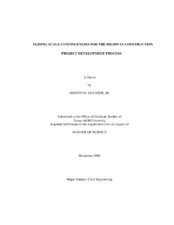Sliding Scale Contingencies for the Highway Construction Project Development Process
Abstract
In the Highway construction project development process, State Highway Agencies
(SHA) prepare cost estimates for effective communication to stakeholders and for
project cost control. Cost estimates prepared in the planning phase of project
development typically in a time range of 10 to 20 years from project letting are
characterized by a great deal of uncertainty due to low scope definition. SHAs typically
include an amount as contingency in the project cost estimate to cover costs due to
unidentified or unquantified risks during project development. However, most of the
methods used by SHAs to apply contingency to projects lack consistency in definition
and application. This leads to poor communication to stakeholders, project cost
escalation and other project control issues due to inaccuracy of baseline cost estimates.
This study developed a set of sliding scale contingencies for estimating contingency on
highway projects taking into consideration the effect of major factors, such as project
complexity that impacts contingency application.
Expert opinion was sought through the use of the Delphi technique. Experimental
techniques were not suitable for this study due to the exploratory nature of the problem
and the lack of data to analyze using empirical methods. The Delphi method typically
consists of a series of rounds called questionnaires. Twenty-three professionals with
experience in risk assessment and cost estimating agreed to participate in the study.
Email was the means of communication using an excel spreadsheet. The assessment was completed in three iterative rounds with controlled feedback to the participants on the
panel at the end of each round.
Sliding scale contingencies were developed for three levels of project complexity: noncomplex
(minor), moderately complex, and most complex (major) projects. The sliding
scale contingencies are presented as a final output of this study. This method of
estimating contingency provides consistent rationale for estimating contingency. Risks
are an inextricable part of the contingency estimating process. Estimators are encouraged
to identify and document risks as justification for contingency values applied to a
project.
Subject
ContingencySliding Scale Contingencies
Highway Project Development Process: Construction Contingency
Uncertainty
Construction Estimate Uncertainties
Contingency Estimation
Contingency Management
Citation
Olumide, Adeniyi O. (2009). Sliding Scale Contingencies for the Highway Construction Project Development Process. Master's thesis, Texas A&M University. Available electronically from https : / /hdl .handle .net /1969 .1 /ETD -TAMU -2009 -12 -7581.
Related items
Showing items related by title, author, creator and subject.
-
Godsey, Robert Lane (Texas A&M University. Libraries, )The present investigation assessed the influence of two procedural variations in progressive relaxation training, using physiological and self report indices of arousal as dependent variables. The mode of presentation ...
-
Hart, Darren E (Texas A&M University, 1987)Not available
-
Tope, Daniel B (Texas A&M University, 2002)This analysis examines the social forces that resulted in the 1996 Personal Responsibility and Work Opportunity Reconciliation Act (PRA96). Historical methods are used to examine shifts in AFDC social policy from 1971 to ...


